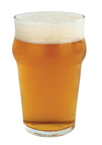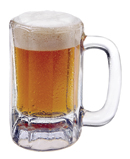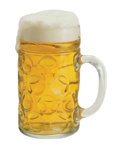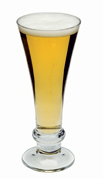The National Beer Wholesalers Association (NBWA) has compiled of list of terms used within the beer industry. You may also be interested in downloading our Beer Types and Styles Guide. To visit our recipe-filled Cooking with Beer page, click on the link to the left.
 Ale - A malt beverage brewed with (usually) barley malt and fermented at relatively high temperatures (60-75 Fº) with top fermenting yeast, which usually creates a fruity taste. Ales are produced with a wide variety of colors, palates and alcoholic strengths. Ale - A malt beverage brewed with (usually) barley malt and fermented at relatively high temperatures (60-75 Fº) with top fermenting yeast, which usually creates a fruity taste. Ales are produced with a wide variety of colors, palates and alcoholic strengths.
Barley Wine - An English term for an extra-strong ale (implied to be as potent as wine).
Bitter - A well-hopped beer similar to pale ale. The difference is essentially that pale ales are bottled whereas bitters are usually only draught beers.
 Bock - German word for strong beer. It is a lager, usually dark, made from barley malt that usually displays a malty sweetness and relatively high alcohol content while limiting the presence of hop bitterness. Bock beers are traditionally served in autumn, late winter or spring. Bock - German word for strong beer. It is a lager, usually dark, made from barley malt that usually displays a malty sweetness and relatively high alcohol content while limiting the presence of hop bitterness. Bock beers are traditionally served in autumn, late winter or spring.
 Brown Ale - A reddish-brown colored ale known in England as a thirst-quencher and displays hints of chocolate and fruity sweetness. American versions are more alcoholic (due to increased malt) and more bitter (due to increased hops) but they still display the basic features of chocolate and fruit. Brown Ale - A reddish-brown colored ale known in England as a thirst-quencher and displays hints of chocolate and fruity sweetness. American versions are more alcoholic (due to increased malt) and more bitter (due to increased hops) but they still display the basic features of chocolate and fruit.
Cask-Conditioned - Draught beer that is neither filtered or pasteurized and has a secondary fermentation and natural clarification in the cellar of the pub. It is served at a cool temperature but not chilled in order to fully exhibit all of its flavors.
 Dopplebock - Double Bock. An extra strong (alcohol content) bock beer that is usually tawny or dark brown in color. Dopplebock - Double Bock. An extra strong (alcohol content) bock beer that is usually tawny or dark brown in color.
Hop - A climbing plant much like a grape vine. Hops contain oils and resins that provide beer with a bittering balance in taste and aroma to the sweetness of the malt. Oils contribute to the taste and aroma with resins acting as bittering agents.
 India Pale Ale - Commonly referred as an "IPA," it is a stronger, hoppier version of a pale ale. The term originates from the difficulties of British brewers to make beer that could sustain the long voyage from England to India in the 1700s. The solution was to add hops to already fermented beer to act as a preserving agent. Hops are now not only added to fermented beer (dry hopping) but are also boiled in the wort. India Pale Ale - Commonly referred as an "IPA," it is a stronger, hoppier version of a pale ale. The term originates from the difficulties of British brewers to make beer that could sustain the long voyage from England to India in the 1700s. The solution was to add hops to already fermented beer to act as a preserving agent. Hops are now not only added to fermented beer (dry hopping) but are also boiled in the wort.
Lager - Any beer fermented at low temperatures using bottom fermenting yeast and then stored (lagered) in cool conditions in order to clear away imperfections to ensure a clean taste. Usually golden in color but can be dark.
 Lambic - Spontaneously fermenting style of beer brewed from malted barley and unmalted wheat and is unique to Belgium. Lambic - Spontaneously fermenting style of beer brewed from malted barley and unmalted wheat and is unique to Belgium.
Light Beer - American term indicating a pilsner-style beer that is relatively low in calories and alcohol content.
Malt - Malt refers to grains that have been soaked in water until they are partially germinated (malted) and then kilned. This releases starches which are turned into fermentable sugar. When yeast is added, these fermentable sugars become alcohol and carbon dioxide. Malt also gives beer its sweet flavor.
 Pale Ale - An ale brewed with pale malts (lightly kilned) giving it an often honey-like or caramel sweetness. They are often bronze or copper colored as opposed to the dark brown or blakc of porters and stouts, hence the term "pale ale." Some English brewers use this term to describe their premium bitters. Pale Ale - An ale brewed with pale malts (lightly kilned) giving it an often honey-like or caramel sweetness. They are often bronze or copper colored as opposed to the dark brown or blakc of porters and stouts, hence the term "pale ale." Some English brewers use this term to describe their premium bitters.
Porter - A London style of beer. It is a lighter-bodied companion to stout. Porters are roasted-tasting dark brews that are bottom-fermented and stronger in alcohol.
Stout - Originally a "Stout Porter." It is a strong porter that is extra-dark, almost black in color, due to the use of highly roasted malts.
 Weisse/Weissbier - A German term for beer made with malted wheat. Weisse/Weissbier - A German term for beer made with malted wheat.
Wort - The sweet liquid made from malted grains, boiling water and hops that yeast cells cause to ferment.
Yeast - Yeast cells love to eat sugar. In doing so, they cause the wort to ferment, which produces alcohol and carbon dioxide. Yeast also conveys its own flavor and can be used to give a fruity flavor to beer. |